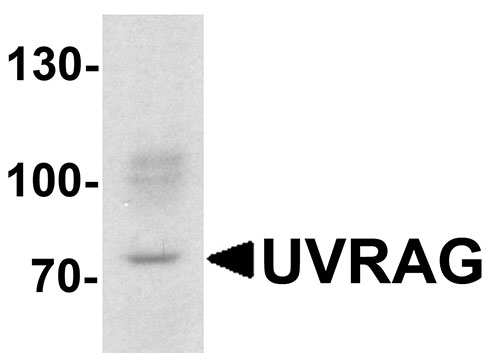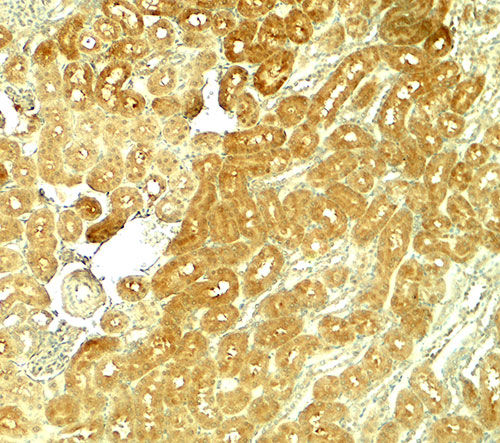SMURF1 Antibody
- 产品详情
- 实验流程
- 背景知识
Application
| WB, E, IHC-P |
|---|---|
| Primary Accession | Q9HCE7 |
| Other Accession | NP_065162, 31317292 |
| Reactivity | Human, Mouse, Rat |
| Host | Rabbit |
| Clonality | Polyclonal |
| Isotype | IgG |
| Calculated MW | 86114 Da |
| Concentration (mg/ml) | 1 mg/mL |
| Conjugate | Unconjugated |
| Application Notes | SMURF1 body can be used for detection of SMURF1 by Western blot at 1 - 2 µg/ml. Antibody can also be used for Immunohistochemistry starting at 5 µg/mL. |
| Gene ID | 57154 |
|---|---|
| Other Names | E3 ubiquitin-protein ligase SMURF1, hSMURF1, 6.3.2.-, SMAD ubiquitination regulatory factor 1, SMAD-specific E3 ubiquitin-protein ligase 1, SMURF1, KIAA1625 |
| Target/Specificity | SMURF1; SMURF1 antibody is human, mouse and rat reactive. At least three isoforms of SMURF1 are known to exist this antibody will recognize all three isoforms. SMURF1 is predicted to not cross-react with SMURF2. |
| Reconstitution & Storage | SMURF1 antibody can be stored at 4℃ for three months and -20℃, stable for up to one year. |
| Precautions | SMURF1 Antibody is for research use only and not for use in diagnostic or therapeutic procedures. |
| Name | SMURF1 |
|---|---|
| Synonyms | KIAA1625 |
| Function | E3 ubiquitin-protein ligase that acts as a negative regulator of BMP signaling pathway. Mediates ubiquitination and degradation of SMAD1 and SMAD5, 2 receptor-regulated SMADs specific for the BMP pathway. Promotes ubiquitination and subsequent proteasomal degradation of TRAF family members and RHOA. Promotes ubiquitination and subsequent proteasomal degradation of MAVS (PubMed:23087404). Acts as an antagonist of TGF-beta signaling by ubiquitinating TGFBR1 and targeting it for degradation (PubMed:21791611). Plays a role in dendrite formation by melanocytes (PubMed:23999003). |
| Cellular Location | Cytoplasm. Cell membrane; Peripheral membrane protein; Cytoplasmic side |
| Tissue Location | Expressed in melanocytes (PubMed:23999003). |
For Research Use Only. Not For Use In Diagnostic Procedures.
Provided below are standard protocols that you may find useful for product applications.
BACKGROUND
SMURF1 (SMAD ubiquitin regulatory factor 1) is a negative regulator of TGF-beta signaling (1). SMURF1 and SMURF2 are members of HECT domain E3 ubiquitin ligase which are involved in the enzymatic reactions of the Ub conjugating pathway (1,2). SMURF1 negatively regulates osteoblast activity and response to bone morphogenesis protein (BMP) through controlling MEKK2 degradation (3). SMURF1 has recently been shown to play a role in breast cancer cell migration and invasion through the downregulation of RhoA (4).
REFERENCES
Huibregtse JM, Scheffner M, Beaudenon S, et al. A family of proteins structurally and functionally related to the E6-AP ubiquitin-protein ligase. Proc. Natl. Acad. Sci. USA 1995; 92:2563-7.
Hwang YS, Lee HS, Kamata T, et al. The Smurf ubiquitin ligases regulate tissue separation via antagonistic interactions with ephrinB1. Genes Dev. 2013; 27:491-503.
Yamashita M, Ying SX, Zhang G, et al. Ubiquitin ligase Smurf1 controls osteoblast activity and bone homeostasis by targeting MEKK2 for degradation. Cell 2005; 121:101-113.
Kwon A, Lee HL, Woo KM, et al. SMURF1 plays a role in EGF-induced breast cancer cell migration and invasion. Mol. Cells 2013; 36:548-55.
终于等到您。ABCEPTA(百远生物)抗体产品。
点击下方“我要评价 ”按钮提交您的反馈信息,您的反馈和评价是我们最宝贵的财富之一,
我们将在1-3个工作日内处理您的反馈信息。
如有疑问,联系:0512-88856768 tech-china@abcepta.com.























 癌症的基本特征包括细胞增殖、血管生成、迁移、凋亡逃避机制和细胞永生等。找到癌症发生过程中这些通路的关键标记物和对应的抗体用于检测至关重要。
癌症的基本特征包括细胞增殖、血管生成、迁移、凋亡逃避机制和细胞永生等。找到癌症发生过程中这些通路的关键标记物和对应的抗体用于检测至关重要。 为您推荐一个泛素化位点预测神器——泛素化分析工具,可以为您的蛋白的泛素化位点作出预测和评分。
为您推荐一个泛素化位点预测神器——泛素化分析工具,可以为您的蛋白的泛素化位点作出预测和评分。 细胞自噬受体图形绘图工具为你的蛋白的细胞受体结合位点作出预测和评分,识别结合到自噬通路中的蛋白是非常重要的,便于让我们理解自噬在正常生理、病理过程中的作用,如发育、细胞分化、神经退化性疾病、压力条件下、感染和癌症。
细胞自噬受体图形绘图工具为你的蛋白的细胞受体结合位点作出预测和评分,识别结合到自噬通路中的蛋白是非常重要的,便于让我们理解自噬在正常生理、病理过程中的作用,如发育、细胞分化、神经退化性疾病、压力条件下、感染和癌症。







